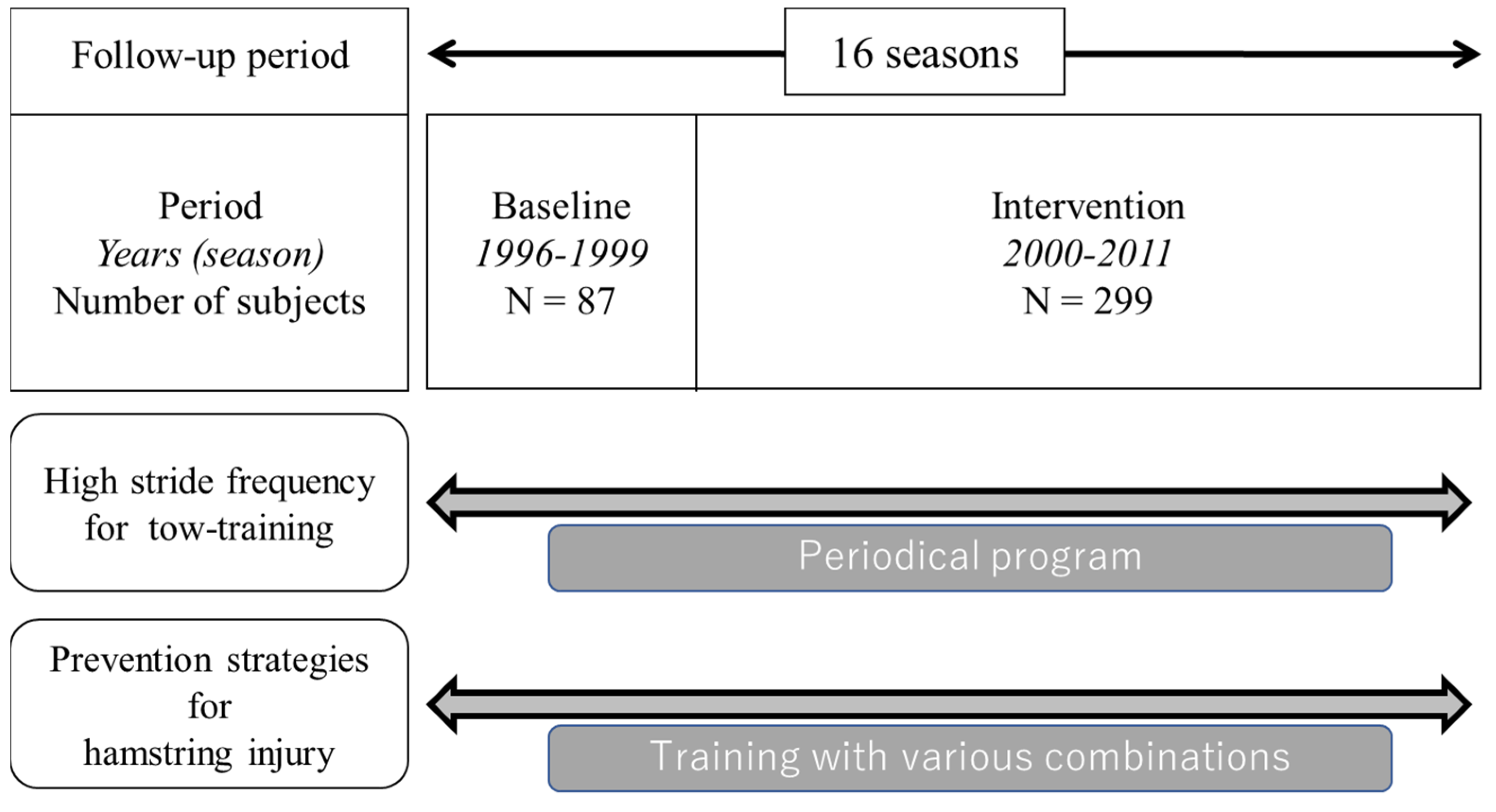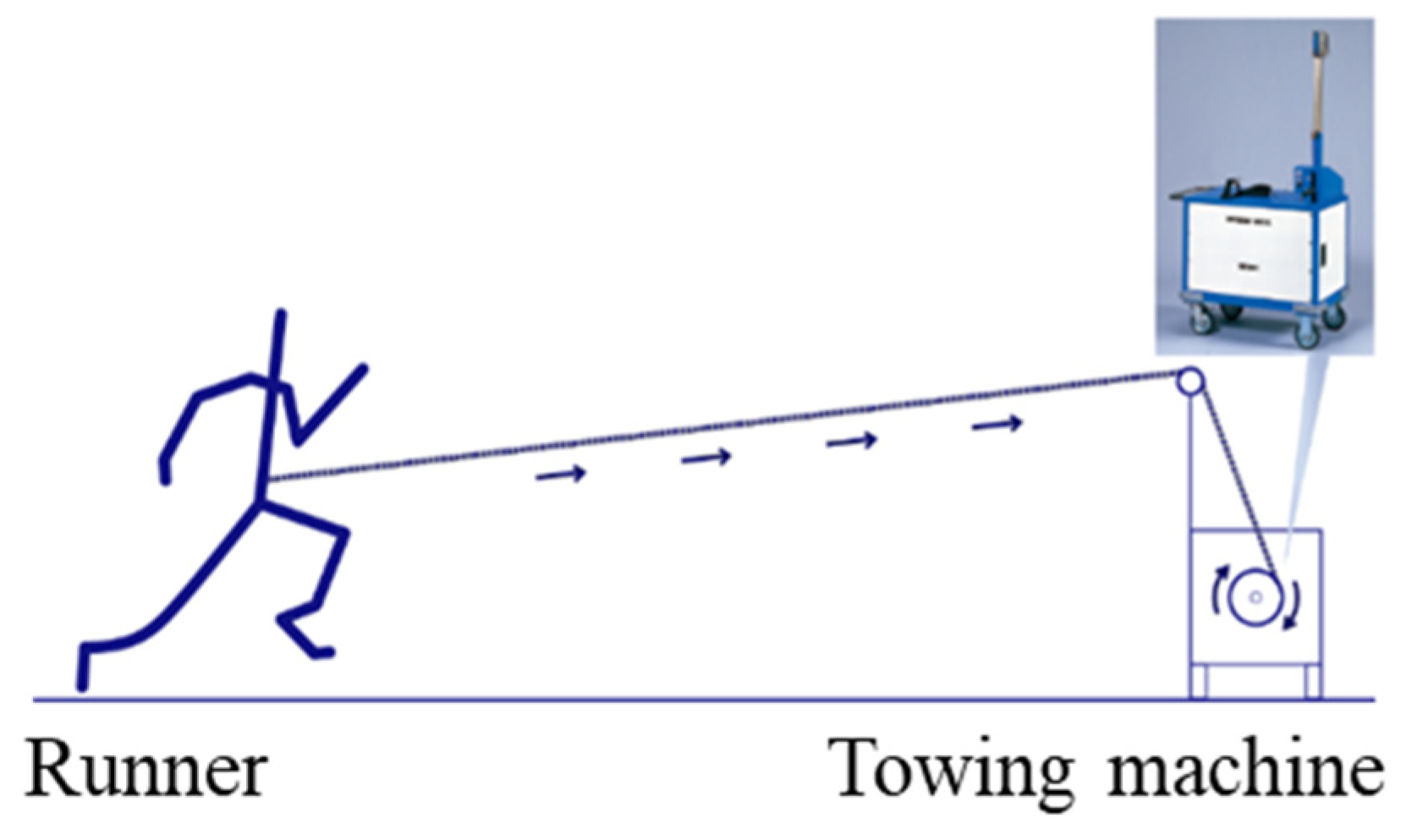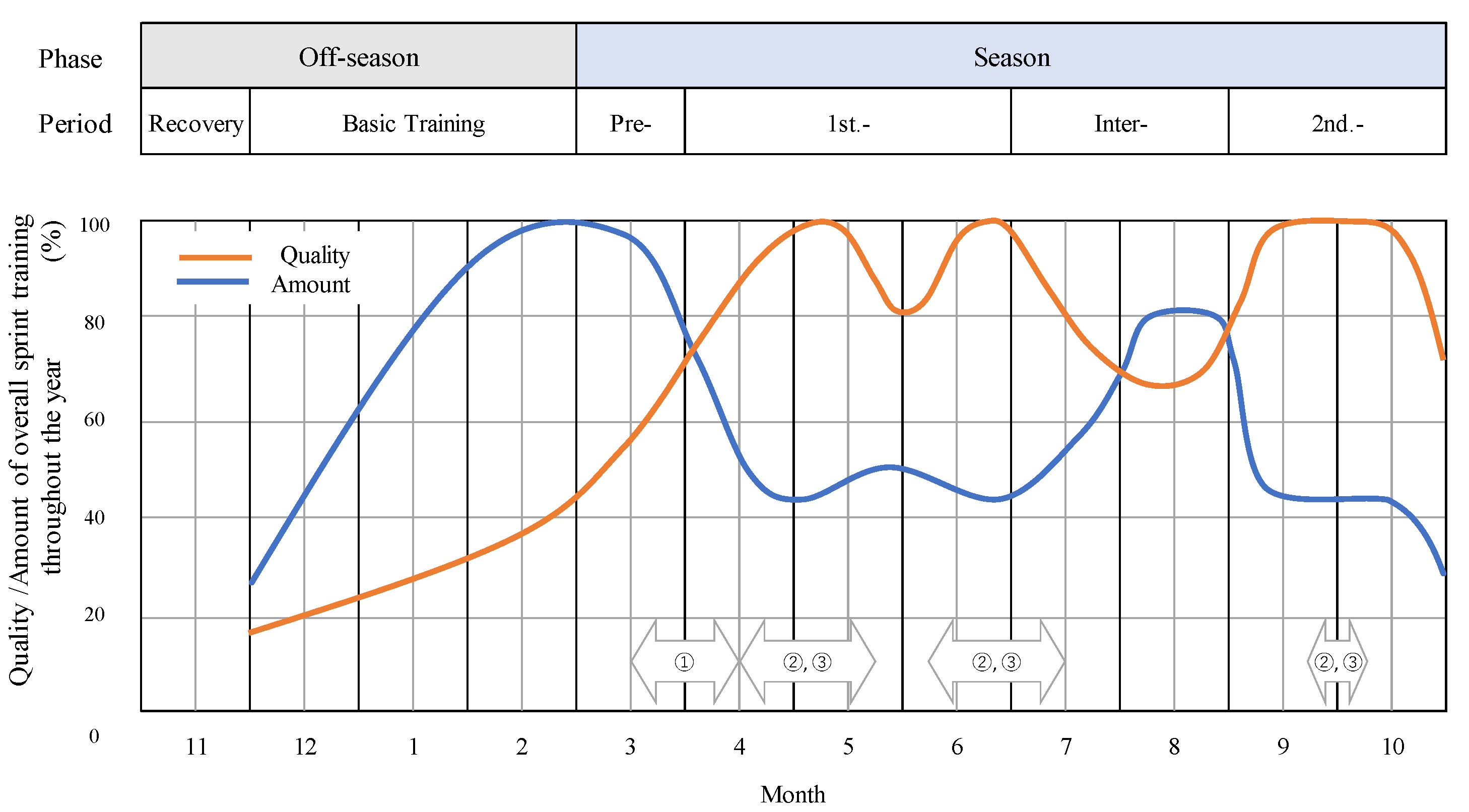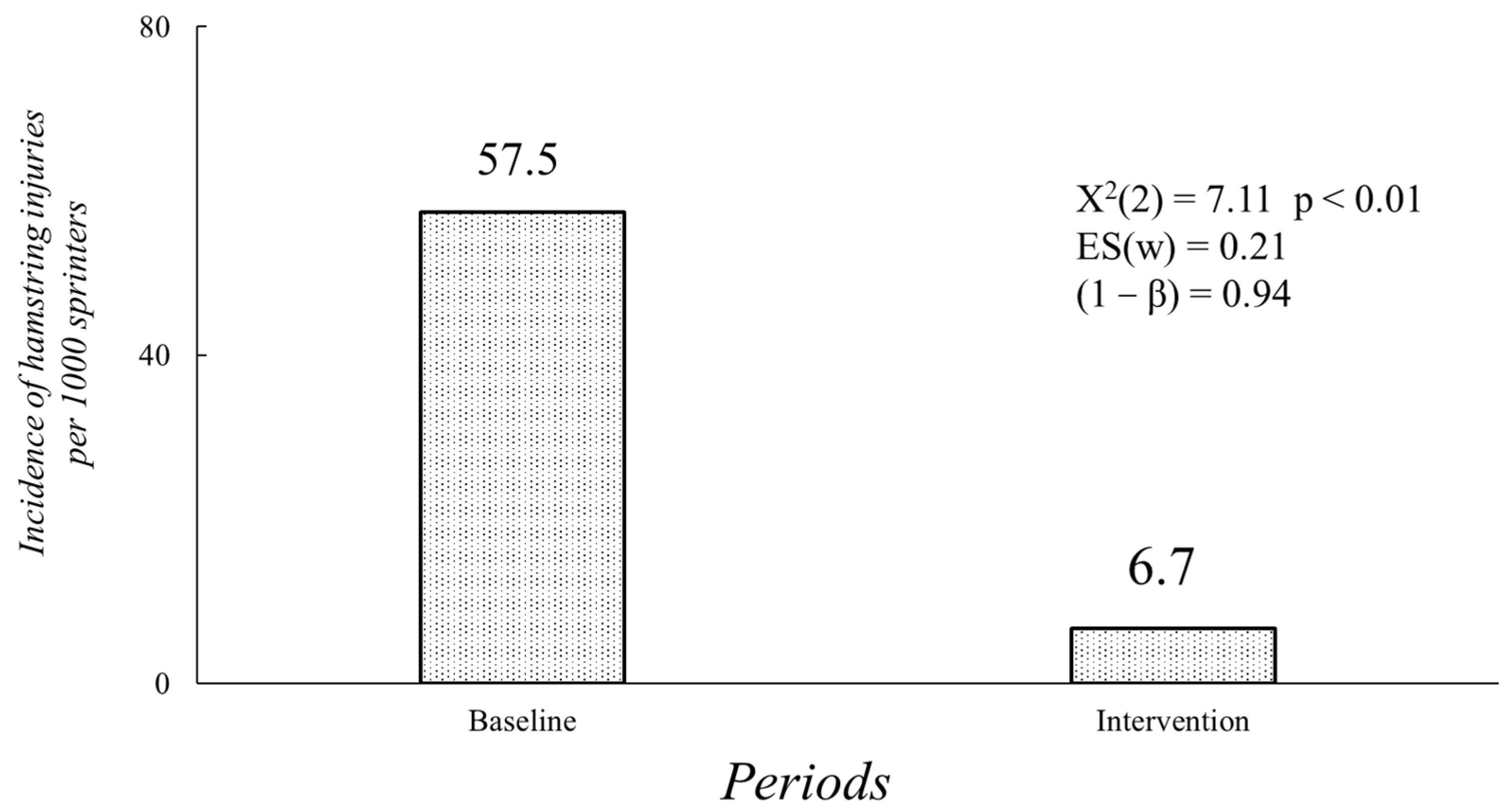Hamstring Injury Prevention Program and Recommendation for Stride Frequency during Tow-Training Optimization
Abstract
:1. Introduction
2. Materials and Methods
2.1. Subjects
2.2. Study Design
2.3. Supramaximal Running
2.4. Hamstring Injury Prevention Program
2.5. Recording Hamstring Injury
2.6. Statistical Analysis
3. Results
3.1. The Number of Stride Frequency during Supramaximal Running
3.2. Incidence of Hamstring Injury
4. Discussion
4.1. Consideration of the Methodology
4.2. Recommendations for a Specific Program to Increase Stride Frequency
4.3. Effects of Agility Training on Hamstring Injury Incidence
4.4. Effects of Strength Training on Hamstring Injury Incidence
4.5. Effects of Flexibility Training on Hamstring Injury Incidence
4.6. Limitation and Implication
5. Conclusions
Author Contributions
Funding
Institutional Review Board Statement
Informed Consent Statement
Data Availability Statement
Conflicts of Interest
References
- Mero, A.; Komi, P.V. Effects of supuramaximal velocity on biomechanical variables in sprinting. J. Appl. Biomech. 1985, 1, 240–252. [Google Scholar]
- Ae, M.; Miyashita, K.; Yokoi, T.; Hashihara, Y. Mechanical power and work done by the muscle of the lower limb during running at different speeds. Biomechanics X-B 1987, 6, 895–899. [Google Scholar]
- Chapman, A.E.; Caldwell, G.E. Kinetic limitations of maximal sprinting speed. J. Biomech. 1983, 16, 79–83. [Google Scholar] [CrossRef]
- Mann, R.V. A kinetic analysis of sprinting. Med. Sci. Sports Exerc. 1981, 13, 325–328. [Google Scholar] [CrossRef] [PubMed]
- Sugiura, Y.; Aoki, J. Effects of supramaximal running on stride frequency and stride length in sprinters. Adv. Exerc. Sports Physiol. 2008, 14, 9–17. [Google Scholar]
- Ae, M.; Itoh, N.; Muraki, Y.; Miyashita, K. Optimal tension of isotonic towing for sprint training. In Proceedings of the XVth Congress of International Society of Biomechanics, Jyvaskyla, Finland, 2–6 July 1995. [Google Scholar]
- Hicks, D. Resisted and assisted sprint training: Determining the transfer to maximal sprinting. New Stud. Athl. 2018, 32, 35–51. [Google Scholar]
- Clark, K.; Cahill, M.; Korfist, C.; Whitacre, T. Acute Kinematic Effects of Sprinting With Motorized Assistance. J. Strength Cond. Res. 2021, 35, 1856–1864. [Google Scholar] [CrossRef]
- Corn, R.; Knudson, D. Effect of elastic-cord towing on the kinematics of the acceleration phase of sprinting. J. Strength Cond. Res. 2003, 17, 72–75. [Google Scholar] [PubMed]
- Mero, A.; Komi, P.V.; Rusko, H.; Hirvonen, J. Neuromuscular and anaerobic performance of sprinters at maximal and supramaximal speed. Int. J. Sports Med. 1987, 1, 55–60. [Google Scholar] [CrossRef]
- Dintiman, G.B. Training the Sprinter. In What Research Tells the Coach about Sprinting; Cooper, J.M., Ed.; Aahper Publications: Washington, DC, USA, 1974; pp. 49–81. [Google Scholar]
- Tanaley, J. Glendale’s Tow Training for Sprinters. Track Tech. 1980, 78, 2473–2475. [Google Scholar]
- Devlin, L. Recurrent posterior thigh symptoms detrimental to performance in rugby union: Predisposing factors. Sports Med. 2000, 29, 273–287. [Google Scholar] [CrossRef]
- Agre, J.C. Hamstring injuries: Proposed aetiological factors, prevention, and treatment. Sports Med. 1985, 2, 21–33. [Google Scholar] [CrossRef]
- Sugiura, Y.; Saito, T.; Sakuraba, K.; Sakuma, K.; Suzuki, E. Strength deficits identified with concentric action of the hip extensors and eccentric action of the hamstrings predispose to hamstring injury in elite sprinters. J. Orthop. Sports Phys. Ther. 2008, 38, 457–464. [Google Scholar] [CrossRef] [PubMed] [Green Version]
- Ito, N. Effects of towing system used a pulley on sprinting. Sprint Res. 1998, 8, 29–37. (In Japanese) [Google Scholar]
- Sugiura, Y.; Migita, T.; Sakuraba, K.; Sakuma, K.; Aoki, J. Effects of tow training on delayed-onset muscle soreness and serum CK activity for sprinters who are accustomed to supramaximal running. Jpn. J. Clin. Sports Med. 2009, 17, 247–254. (In Japanese) [Google Scholar]
- Mero, A.; Komi, P.V. Force-, EMG-, and elasticity-velocity relationships at submaximal, maximal and supramaximal running speeds in sprinters. Eur. J. Appl. Physiol. Occup. Physiol. 1986, 55, 553–561. [Google Scholar] [CrossRef] [PubMed]
- Sugiura, Y.; Sakuma, K.; Sakuraba, K.; Sato, Y. Prevention of Hamstring Injuries in Collegiate Sprinters. Orthop. J. Sports Med. 2017, 5, 1–5. [Google Scholar] [CrossRef]
- Arnason, A.; Andersen, T.E.; Holme, I.; Engebretsen, L.; Bahr, R. Prevention of hamstring strains in elite soccer: An intervention study. Scand. J. Med. Sci. Sports 2008, 18, 40–48. [Google Scholar] [CrossRef]
- Mjølsnes, R.; Arnason, A.; Osthagen, T.; Raastad, T.; Bahr, R. A 10-week randomized trial comparing eccentric vs. concentric hamstring strength training in well-trained soccer players. Scand. J. Med. Sci. Sports 2004, 14, 311–317. [Google Scholar] [CrossRef]
- Joyce, D.; Lewindon, D. Retraining the injured athlete. In High-Performance Training for Sports; Joyce, D., Lewindon, D., Eds.; Human Kinetics: Champaign, IL, USA, 2014; pp. 86–96. [Google Scholar]
- De Vries, H.A. Flexibility. In Physiology of Exercise, 4th ed.; de Vries, H.A., Ed.; Brown Publishers: Dubuque, IA, USA, 1986; pp. 461–472. [Google Scholar]
- Thacker, S.B.; Gilchrist, J.; Stroup, D.F.; Kimsey, C.D., Jr. The impact of stretching on sports injury risk: A systematic review of the literature. Med. Sci. Sports Exerc. 2004, 36, 371–378. [Google Scholar] [CrossRef]
- Orchard, J.; Marsden, J.; Lord, S.; Garlick, D. Preseason hamstring muscle weakness associated with hamstring muscle injury in Australian footballers. Am. J. Sports Med. 1997, 25, 81–85. [Google Scholar] [CrossRef]
- Brockett, C.L.; Morgan, D.L.; Proske, U. Predicting hamstring strain injury in elite athletes. Med. Sci. Sports Exerc. 2004, 36, 379–387. [Google Scholar] [CrossRef] [Green Version]
- Alonso, J.M.; Edouard, P.; Fischetto, G.; Adams, B.; Depiesse, F.; Mountjoy, M. Determination of future prevention strategies in elite track and field: Analysis of Daegu 2011 IAAF Championships injuries and illnesses surveillance. Br. J. Sports Med. 2012, 46, 505–514. [Google Scholar] [CrossRef] [Green Version]
- Alonso, J.M.; Tscholl, P.M.; Engebretsen, L.; Mountjoy, M.; Dvorak, J.; Junge, A. Occurrence of injuries and illnesses during the 2009 IAAF World Athletics Championships. Br. J. Sports Med. 2010, 44, 1100–1105. [Google Scholar] [CrossRef]
- Junge, A.; Engebretsen, L.; Alonso, J.M.; Renström, P.; Mountjoy, M.; Aubry, M.; Dvorak, J. Injury surveillance in multi-sport events: The International Olympic Committee approach. Br. J. Sports Med. 2008, 42, 413–421. [Google Scholar] [CrossRef] [PubMed]
- Orchard, J. Biomechanics of muscle strain injury. N. Z. J. Sports Med. 2002, 30, 90–98. [Google Scholar]
- Simonsen, E.B.; Thomsen, L.; Klausen, K. Activity of mono-and biarticular leg muscles during sprint running. Eur. J. Appl. Physiol. Occup. Physiol. 1985, 54, 524–532. [Google Scholar] [CrossRef] [PubMed]
- Stanton, P. Hamstring injuries and eccentric exercise. Excel 1986, 3, 13–15. [Google Scholar]
- Stanton, P.; Purdam, C. Hamstring injuries in sprinting—The role of eccentric exercise. J. Orthop. Sports Phys. Ther. 1989, 10, 343–349. [Google Scholar] [CrossRef] [PubMed]
- Vasudevan, E.V.; Bastian, A.J. Sprit-belt treadmill adaptation shows Different functional networks for fast and slow human walking. J. Neurophysiol. 2010, 103, 183–191. [Google Scholar] [CrossRef] [Green Version]
- Proske, U.; Morgan, D.L.; Brockett, C.L.; Percival, P. Identifying athletes at risk of hamstring strains and how to protect them. Clin. Exp. Phamacol. Physiol. 2004, 31, 546–550. [Google Scholar] [CrossRef]
- Brockett, C.L.; Morgan, D.L.; Proske, U. Human hamstring muscles adapt to eccentric exercise by changing optimum length. Med. Sci. Sports Exerc. 2001, 33, 783–790. [Google Scholar] [CrossRef] [Green Version]
- Askling, C.; Karlsson, J.; Thorstensson, A. Hamstring injury occurrence in elite soccer players after preseason strength training with eccentric overload. Scand. J. Med. Sci. Sports 2003, 13, 244–250. [Google Scholar] [CrossRef]
- Van Dyk, N.; Behan, F.P.; Whiteley, R. The Nordic hamstring exercise in injury prevention programmes halves the rate of hamstring injuries: A systematic review and meta-analysis of 8459 athletes. Br. J. Sports Med. 2019, 53, 1362–1370. [Google Scholar] [CrossRef] [PubMed] [Green Version]
- Heiderscheit, B.C.; Sherry, M.A.; Silder, A.; Chumanov, E.S.; Thelen, D.G. Hamstring strain injuries: Recommendations for diagnosis, rehabilitation, and injury prevention. J. Orthop. Sports Phys. Ther. 2010, 40, 67–81. [Google Scholar] [CrossRef] [PubMed] [Green Version]
- Ditroilo, M.; De Vito, G.; Delahunt, E. Kinematic and electromyographic analysis of the nordic hamstring exercise. J. Electromyogr. Kinesiol. 2013, 23, 11–18. [Google Scholar] [CrossRef] [PubMed]
- Iga, J.; Fruer, C.S.; Deighan, M.; Croix, M.D.S.; James, D.V.B. “Nordic” hamstring exercise—Engagement characteristics and training responses. Int. J. Sports Med. 2012, 33, 1000–1004. [Google Scholar] [CrossRef]
- Ribeiro-Alvares, J.B.; Marques, V.B.; Vaz, M.A.; Baroni, B.M. Four Weeks of Nordic Hamstring Exercise Reduce Muscle Injury Risk Factors in Young Adults. J. Strength Cond. Res. 2018, 32, 1254–1262. [Google Scholar] [CrossRef]
- Alonso, J.; McHugh, M.P.; Mullaney, M.J.; Tyler, T.F. Effect of hamstring flexibility on isometric knee flexion angle-torque relationship. Scand. J. Med. Sci. Sports 2009, 19, 252–256. [Google Scholar] [CrossRef]
- Holt, J.; Holt, L.E.; Pelham, T.W. Flexibility redefined. In Proceedings of the XIIIth International Symposium for Biomechanics in Sport, Thunder Bay, ON, Canada, 18–22 July 1995; pp. 170–174. [Google Scholar]
- McHugh, M.P.; Cosgrave, C.H. To stretch or not to stretch: The role of stretching in injury prevention and performance. Scand. J. Med. Sci. Sports 2010, 20, 169–181. [Google Scholar] [CrossRef]
- Goldman, E.F.; Jones, D.E. Interventions for preventing hamstring injuries: A systematic review. Physiotherapy 2011, 97, 91–99. [Google Scholar] [CrossRef]
- Woods, C.; Hawkins, R.D.; Maltby, S.; Hulse, M.; Thomas, A.; Hodson, A. The Football Association Medical Research Programme: An audit of injuries in professional football-analysis of hamstring injuries. Br. J. Sports Med. 2004, 38, 36–41. [Google Scholar] [CrossRef] [PubMed] [Green Version]
- Shrier, I. Dose stretching improve performance? A systematic and critical review of the literature. Clin. J. Sport Med. 2004, 14, 267–273. [Google Scholar] [CrossRef] [PubMed]
- Winchester, J.B.; Nelson, A.G.; Landin, D.; Young, M.A.; Schexnayder, I.C. Static stretching impairs sprint performance in collegiate track and field athletes. J. Strength Cond. Res. 2008, 22, 13–19. [Google Scholar] [CrossRef] [PubMed] [Green Version]
- Little, T.; Williams, A.G. Effects of differential stretching protocols during warm-ups on high-speed motor capacities in professional soccer players. J. Strength Cond. Res. 2006, 20, 203–207. [Google Scholar]
- McMillian, D.J.; Moore, J.H.; Hatler, B.S.; Taylor, D.C. Dynamic vs. static-stretching warm up: The effect on power and agility performance. J. Strength Cond. Res. 2006, 20, 492–499. [Google Scholar] [CrossRef] [PubMed] [Green Version]
- Yamaguchi, T.; Ishii, K. An optimal protocol for dynamic stretching to improve explosive performance. J. Phys. Fitness Sports Med. 2014, 3, 121–129. [Google Scholar] [CrossRef]
- Papadopoulos, G.S.T.; Kellis, S. The effect of static and dynamic stretching exercises on the maximal isokinetic strength of the knee extensors and flexors. Isokinet. Exerc. Sci. 2005, 13, 285–291. [Google Scholar] [CrossRef]
- Opplert, J.; Babault, N. Acute Effects of Dynamic Stretching on Muscle Flexibility and Performance: An Analysis of the Current Literature. Sports Med. 2018, 48, 299–325. [Google Scholar] [CrossRef]




| Objective and Method | Action and/or Motion (Load) | Period | |
|---|---|---|---|
| Baseline | Intervention | ||
| Strength | |||
| Weight machine | ˙Knee flexors concentrically (leg curl) | ● | ● |
| (3/5-4/5 of body weight by 10 repetitions × 3–5 sets) | |||
| ˙Hip extensors concentrically (hip extension) | ● | ● | |
| (4/5-5/5 of body weight by 10 repetitions × 3–5 sets) | |||
| Body weight | ˙Knee flexors eccentrically (Nordic hamstring exercise) | ● | |
| (lean forward slowly by 30–60 s × 5 sets) | |||
| ˙Knee flexors eccentrically and hip extensors/knee flexors concentrically (glute-ham raise) | ● | ||
| (lean forward, downward, and upward by 10–20 repetitions × 5 sets) | |||
| Agility | |||
| Ladder | ˙5 types of fast stepping in all directions | ● | ● |
| (10 m by 4 repetitions) | |||
| Mini-hurdle | ˙4 types of one and/or both leg(s) with fast stepping | ● | ● |
| (10 hurdles by 4 repetitions) | |||
| Flexibility | |||
| Dynamic stretching | ˙3 types of stretching for muscles around hip joint | ● | |
| (20 m by 1 repetition) | |||
Publisher’s Note: MDPI stays neutral with regard to jurisdictional claims in published maps and institutional affiliations. |
© 2021 by the authors. Licensee MDPI, Basel, Switzerland. This article is an open access article distributed under the terms and conditions of the Creative Commons Attribution (CC BY) license (https://creativecommons.org/licenses/by/4.0/).
Share and Cite
Sugiura, Y.; Sakuma, K.; Fujita, S.; Sakuraba, K. Hamstring Injury Prevention Program and Recommendation for Stride Frequency during Tow-Training Optimization. Appl. Sci. 2021, 11, 6500. https://doi.org/10.3390/app11146500
Sugiura Y, Sakuma K, Fujita S, Sakuraba K. Hamstring Injury Prevention Program and Recommendation for Stride Frequency during Tow-Training Optimization. Applied Sciences. 2021; 11(14):6500. https://doi.org/10.3390/app11146500
Chicago/Turabian StyleSugiura, Yusaku, Kazuhiko Sakuma, Shimpei Fujita, and Keishoku Sakuraba. 2021. "Hamstring Injury Prevention Program and Recommendation for Stride Frequency during Tow-Training Optimization" Applied Sciences 11, no. 14: 6500. https://doi.org/10.3390/app11146500
APA StyleSugiura, Y., Sakuma, K., Fujita, S., & Sakuraba, K. (2021). Hamstring Injury Prevention Program and Recommendation for Stride Frequency during Tow-Training Optimization. Applied Sciences, 11(14), 6500. https://doi.org/10.3390/app11146500






